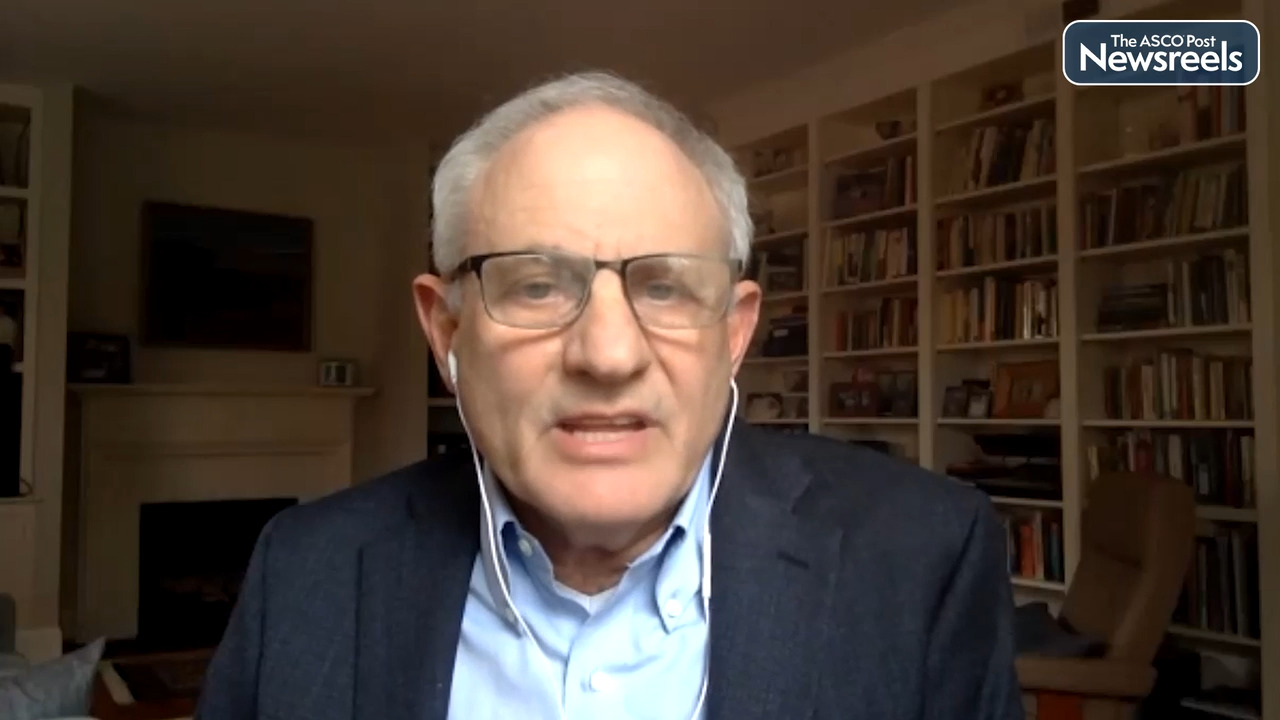Michael A. Postow, MD, on Using the Novel Radiotracer Crefmirlimab Berdoxam for Imaging to Assess Immunotherapy Responsiveness
SITC 2022
Michael A. Postow, MD, of Memorial Sloan Kettering Cancer Center, discusses new findings on the correlation between CD8 cell PET imaging with zirconium-89–crefmirlimab berdoxam and CD8 cell immunohistochemistry in patients with advanced cancer receiving immunotherapy. Noninvasive CD8 PET scanning with crefmirlimab berdoxam permits whole-patient, longitudinal CD8 assessment, which is currently under investigation as a biomarker for immunotherapy responsiveness and may be a useful tool for immunotherapy development and clinical management (Abstract 1472).
Transcript
Disclaimer: This video transcript has not been proofread or edited and may contain errors.
We conducted the iCorrelate study to test a new CD8 PET tracer that's in clinical development and to try to see how well the CD8 PET tracer correlated with CD8 immunohistochemistry, which is the standard way to get CD8 cells determined by a biopsy. And for a long time we've tried to understand the presence of CD8 cells in tumor microenvironments and how important are they for effective antitumor immunity? And most studies have shown that the presence of CD8 T-cells in tumor microenvironments by biopsy is associated with favorable anti-tumor effects.
But the idea of this, is that biopsies only sample one small piece of a tumor and it only gets one tumor at one specific time point. So the concept behind CD8 PET imaging, is that you could take a picture of an entire patient and look at all of their tumors and all of the CD 8 cells that might be in the tumor. And hopefully that will give you a better picture of the immune micro environments of all the tumors in a patient and see how they change over time during treatment.
And as part of this investigation, the CD8 PET tracer crefmirlimab has been investigated in prior phase one studies. It's been shown to be safe and feasible. And the question we wanted to embark upon in the iCorrelate phase two study, is to try to see if this CD8 PET tracer correlated with CD8 immunohistochemical staining in a standard biopsy.
And what we found was depending on the different type of PET parameter that we looked at, whether it was the maximum SUV index or the mean SUV index, which is average of a region, how much it lights up on a PET scan? There were different correlation coefficients that related to the degree to which the CD8 PET imaging with the crefmirlimab infusion correlated to the CD8 by biopsy.
In certain subgroups like renal cell carcinoma patients, there was a pretty good correlation of 0.77 between the CD8 PET tracer and what was seen on biopsy for these patients so that was a pretty good correlation. Some of the other correlations varied a bit, and I think the reason that the correlations varied a bit among these different subgroups is, because it's very difficult to correlate a single core needle biopsy with an image. You have to call the imaging characteristics exactly where the core needle biopsy was taken.
So any discrepancy between where the tumor was biopsied and what imaging we're looking at, it might result in a correlation that's a little bit imperfect. But despite the limitations of this very difficult study to do, correlation coefficient of 0.52 for the entire study population, I think is interesting. And I think it merits ongoing evaluation.
So what we're trying to do to take this to the next step now in moving this forward is, to try to really determine how much CD8 PET imaging with crefmirlimab could be used as a biomarker for predicting immunotherapy responsiveness. It's great if it correlates with T-cell presence by biopsy, but what we really want to know is, can it help you pick out which patients are going to respond to immune therapy and which patients are not going to respond to immune therapy or tell you something about the drugs that are being tested in clinical trials in that, are they doing what they're intending to do?
And so a number of ongoing clinical trials are testing the CD8 PET imaging with new different immunotherapy drugs to try to see if there's a relationship with the degree of CD8 PET infiltration and what we can see on a PET scan and with what ultimately happens to the patients that we're treating with the number of these immune therapies. And I think we're excited to see all those results.
The ASCO Post Staff
Kishu Ranjan, PhD, of Yale University School of Medicine, discusses his study findings, which identified a deficiency in the biomarker TAP2 as a prominent immune evasion mechanism in patients whose non–small cell lung cancer has resisted immunotherapy (Abstract 148).
The ASCO Post Staff
Michael B. Atkins, MD, of Georgetown Lombardi Comprehensive Cancer Center, explores recent clinical trials in immuno-oncology in which the phase III trial produced markedly different results from the phase II trial. To help understand the potential value to patients of late-stage trials of treatment combinations, the Society for Immunotherapy of Cancer has developed a checklist for investigators, applicable to any regimen in which immune modulation is an important component of the antitumor effect.
The ASCO Post Staff
Sumanta Pal, MD, of the City of Hope Comprehensive Cancer Center, discusses phase I results from the COBALT-RCC study, a first-in-human clinical trial exploring CD70 CAR T-cell therapy in patients with clear cell renal cell carcinoma. The agent appeared to show an excellent safety profile with no unexpected toxicities and antitumor activity. One durable complete response is the first to be achieved with allogeneic CAR T-cell therapy in patients with relapsed or refractory solid tumors, offering proof of concept for further exploration of CD70-targeted CAR T cells in renal cell and other CD70-positive malignancies (Abstract 558).
The ASCO Post Staff
Talal El Zarif, MD, of Dana-Farber Cancer Institute, and Abdul Rafeh Naqash, MD, of Stephenson Cancer Center at The University of Oklahoma, discuss the results of their cohort study of patients living with HIV and metastatic non–small cell lung cancer, who are often underrepresented in clinical trials, and the safety and efficacy of treating this unique population with immune checkpoint inhibitors (ICIs). The data showed that patients living with HIV and lung cancer had similar toxicity profiles and clinical outcomes as did those who did not have HIV and received ICIs (Abstract 437).
The ASCO Post Staff
Antoni Ribas, MD, PhD, of the University of California, Los Angeles, discusses a phase I study that used CRISPR gene editing to simultaneously “knock out” endogenous T-cell receptors and replace them with personalized neoantigen T-cell receptors in patients with solid tumors. The edited TCR T-cell products were safely infused and trafficked to the tumor lesions (Abstract 1478).





